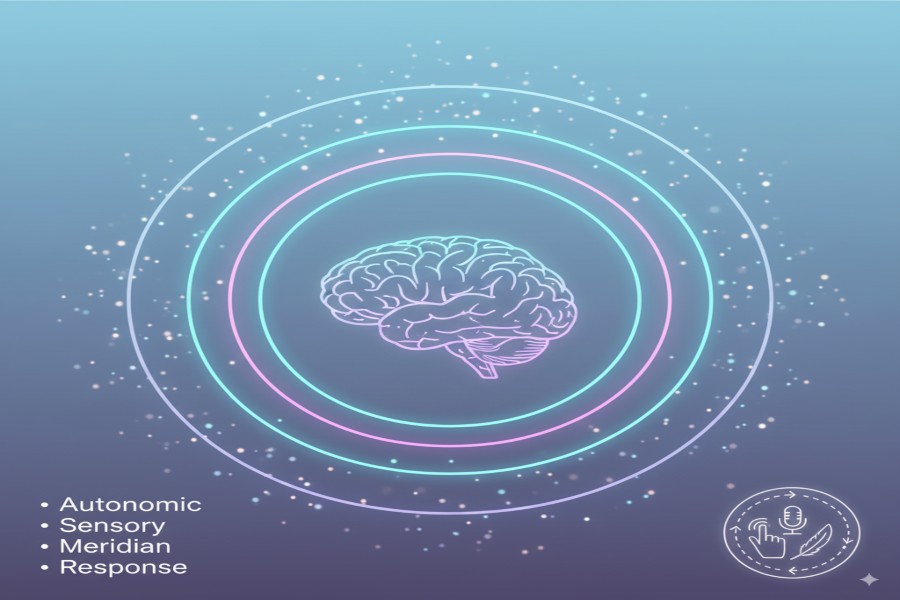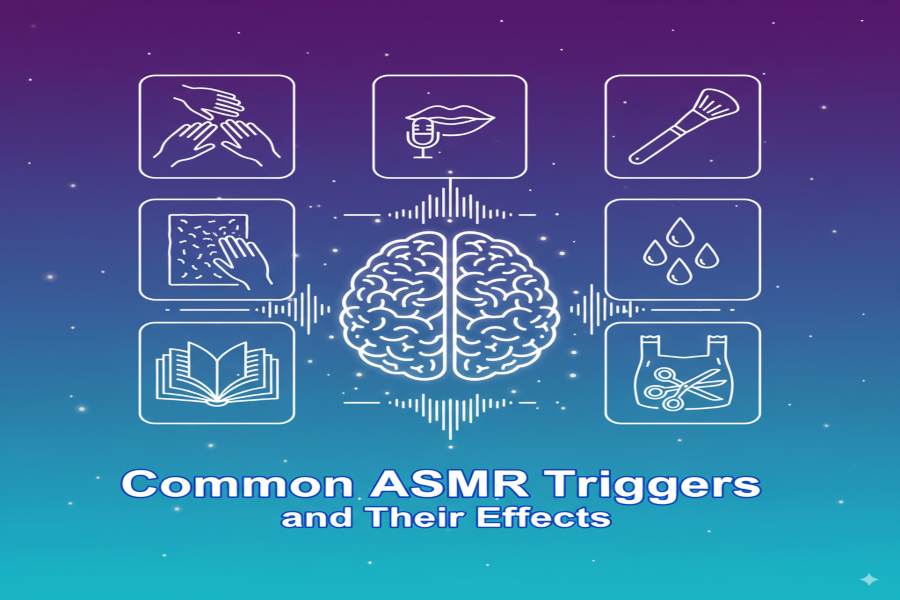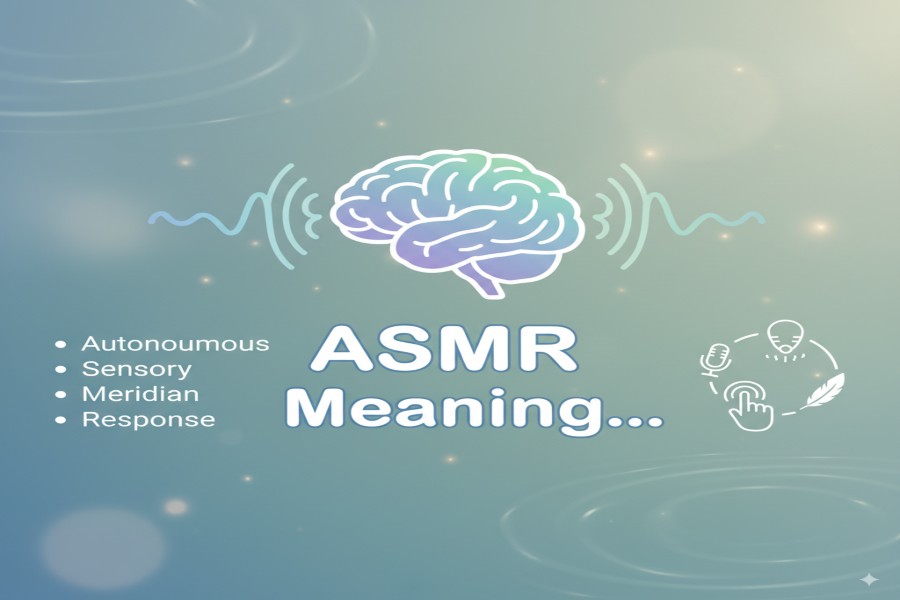The digital age has introduced countless new trends, but few have captured global attention like ASMR. Millions of people now search for this term daily, watch videos for hours, and build entire communities around it. Yet, for many, ASMR remains mysterious. What is ASMR? Why do some feel soothing tingles from certain sounds while others feel nothing? And does science actually support it?
This article unpacks the meaning of ASMR, its triggers, the research behind it, and its cultural rise. By the end, you’ll understand why ASMR matters, how it affects the brain and body, and what role it plays in modern social media and wellness.
What Does ASMR Mean?
ASMR stands for Autonomous Sensory Meridian Response. It describes a tingling sensation, often starting at the scalp and moving down the neck and spine. People who experience it say the feeling is pleasant, calming, and sometimes even euphoric.

The response is usually triggered by specific auditory or visual cues. Whispering, tapping, brushing, or slow movements are common examples. While the exact cause is still unknown, ASMR has become recognized as a real sensory phenomenon, with millions reporting its effects.
How ASMR Feels
People describe ASMR in different ways:
- A tingling or static-like sensation on the skin.
- Waves of relaxation running down the spine.
- A warm, calm state that helps with stress relief.
- A mood boost similar to meditation or massage.
Not everyone experiences ASMR. Research shows some people are highly sensitive to it, while others feel nothing even with the most popular triggers.
Common ASMR Triggers
Whispering
One of the most popular triggers. Gentle whispers create intimacy and calm, often paired with roleplay scenarios.
Tapping
Soft, repetitive tapping on wood, glass, or plastic produces rhythmic sounds that many find soothing.
Brushing
The sound of hair brushing or makeup brushes against surfaces is another well-loved trigger.
Crinkling
Crisp sounds like paper, foil, or packaging being crinkled can create tingling sensations.
Eating Sounds
Chewing, sipping, or crunching sounds divide opinions but attract huge audiences online.
Visual Triggers
Slow hand movements, personal attention roleplays, and light patterns can also activate ASMR for many.
Science Behind ASMR
For years, people debated whether ASMR was real or imagined. Recent studies now confirm physiological changes during ASMR experiences.
A 2017 peer-reviewed study published in PeerJ found that people who experience ASMR show:
- Lower heart rate during ASMR videos.
- Higher skin conductance response, indicating physical arousal.
- Mood improvements, with reduced stress and sadness.
Meanwhile, research from Nebraska Medicine highlights ASMR’s potential benefits for sleep, relaxation, and mental well-being. Scientists note that not everyone responds to ASMR, but those who do experience measurable changes.
The bottom line: ASMR is not just “in the head.” It produces genuine physical effects.
Mental Health and Relaxation Benefits
Many people turn to ASMR videos as tools for self-care. Reported benefits include:
- Reduced anxiety and stress.
- Easier sleep and relief from insomnia.
- Temporary distraction from intrusive thoughts.
- A calming ritual similar to meditation.
Some mental health professionals acknowledge ASMR’s role in helping people cope, though they emphasize it should not replace therapy or medical treatment.
ASMR and Social Media
The rise of ASMR is tied to social media platforms. YouTube has millions of ASMR channels, while TikTok has pushed it to new audiences with short clips. Influencers and creators experiment with microphones, cameras, and props to create immersive experiences.
This growth has turned ASMR into both an art form and an industry. Brands even use ASMR in advertising, recognizing its appeal in capturing attention and creating emotional responses.
However, experts also caution about screen overuse. While ASMR can help with stress, relying too heavily on digital content can increase dependence on devices.
Criticism and Skepticism
Not everyone supports ASMR. Common criticisms include:
- Some find ASMR videos irritating or uncomfortable.
- Eating sounds, in particular, can trigger negative reactions.
- Skeptics argue more large-scale studies are needed.
- Concerns exist about commercialization overshadowing authenticity.
Still, despite the doubts, ASMR continues to grow. The sheer volume of users reporting real benefits makes it hard to dismiss.
ASMR vs. Other Relaxation Methods
ASMR is not the only relaxation tool. People compare it with meditation, mindfulness, and white noise. Unlike these, ASMR is more personal and trigger-specific. Meditation teaches self-awareness, while ASMR relies on external cues. Both can complement each other, depending on individual preference.
The Global Reach of ASMR
ASMR is now a worldwide phenomenon. From North America to Asia, creators build content in multiple languages, showing its universal appeal. In South Korea, “mukbang” (eating shows) overlap with ASMR. In Europe, roleplay-style ASMR is common.
The global spread shows ASMR’s unique power to connect people across cultures through shared sensory experiences.
Potential Concerns
While ASMR is generally safe, a few issues deserve attention:
- Overuse: Watching ASMR for hours may interfere with sleep or productivity.
- Misuse: Some creators blend ASMR with inappropriate content, which can mislead viewers.
- Lack of regulation: As with all online content, quality varies greatly.
Experts recommend enjoying ASMR in moderation and remembering it is a tool, not a cure-all.
The Future of ASMR
Looking ahead, ASMR may expand beyond YouTube and TikTok. Emerging trends include:
- Virtual reality ASMR for immersive experiences.
- Therapeutic use in stress management programs.
- Brand partnerships for marketing and advertising.
- Clinical studies to explore long-term benefits for mental health.
As more research comes out, ASMR may shift from a niche trend to a mainstream wellness practice.
Neuroscience Behind ASMR
Researchers are beginning to map what happens in the brain during ASMR episodes. Functional MRI scans suggest that regions involved in emotional regulation and reward processing activate during triggers. The medial prefrontal cortex and nucleus accumbens show activity similar to responses from music chills or social bonding.
Unlike general relaxation, ASMR appears tied to interpersonal cues. The brain treats whispers or close-attention roleplays as if someone is offering genuine care. This explains why many ASMR videos mimic personal service scenarios such as medical checkups, spa treatments, or tutoring sessions.
Who Experiences ASMR?
Not everyone feels ASMR. Estimates suggest around 20% of the population may experience strong tingles, while others feel milder relaxation. Demographics show no strict boundaries of age or gender, though surveys indicate young adults report the highest usage of ASMR content.
There is also evidence of genetic and psychological factors. Some people are more responsive to sensory stimuli overall. Personality traits like openness to experience and empathy correlate with stronger ASMR reactions.
ASMR in Education
Teachers and students are experimenting with ASMR as a learning aid. Calm, whisper-style narration paired with gentle background sounds is used in reading practice, language learning, and even science tutorials. Early reports show students feel less anxious and more focused.
However, educators caution that ASMR should not replace structured teaching methods. Instead, it can serve as a supplementary tool to reduce classroom stress and improve concentration.
ASMR in Advertising and Branding
Major brands have noticed ASMR’s power to capture attention. Companies in food, cosmetics, and technology have integrated ASMR elements into commercials. Examples include soda cans opening with crisp fizz sounds or makeup brushes gliding across skin in slow motion.
These campaigns aim to stand out in crowded digital spaces. The use of ASMR in marketing demonstrates its psychological impact and its role in consumer behavior. While effective, some critics argue that brands risk trivializing ASMR’s therapeutic value.
The Creator Economy of ASMR
ASMR has become a career path for many content creators. YouTube and TikTok channels with millions of subscribers generate income through ad revenue, sponsorships, and merchandise. Some creators specialize in niche triggers such as roleplays, eating sounds, or object tapping.
Patreon and subscription platforms allow fans to pay for personalized ASMR content. Viewers often request custom triggers tailored to their preferences. This creator-audience relationship highlights ASMR’s intimacy and trust-based appeal.
Therapeutic Applications Under Study
Mental health specialists are exploring how ASMR may assist in therapy settings. Small-scale trials suggest ASMR can reduce heart rate and cortisol levels, which are markers of stress. Psychologists are testing ASMR as an adjunct for anxiety management and sleep therapy.
Hospitals are also experimenting with ASMR to help patients manage pre-surgery stress. Early feedback indicates it may lower nervous tension in waiting rooms. More robust clinical trials are needed, but the potential is significant.
ASMR and Sleep Research
Insomnia affects millions worldwide. ASMR is now included in discussions about non-pharmaceutical sleep aids. Studies show that viewers who watch ASMR before bedtime report falling asleep faster and staying asleep longer.
Wearable devices tracking sleep cycles confirm improvements in certain users. While not a cure for chronic sleep disorders, ASMR provides a natural option for short-term relief without medication side effects.
Cross-Cultural Perspectives
In different cultures, ASMR is framed in unique ways. In Japan, sound-focused relaxation videos known as “otoshimi” overlap with ASMR. In Korea, “mukbang” eating broadcasts blend social interaction with sound triggers.
These cultural variants show ASMR adapts to local traditions of care and comfort. They also explain why ASMR’s popularity spreads across languages and regions, despite varying triggers.
Ethical Considerations
With rapid growth come ethical debates. Some concerns include:
- Child creators: Young ASMR creators may face risks of exploitation or inappropriate attention.
- Boundaries: Personal attention roleplays can blur lines between therapeutic content and suggestive material.
- Commercialization: Heavy monetization raises questions about authenticity and audience trust.
Content platforms are under pressure to create guidelines ensuring ASMR remains safe, creative, and accessible.
ASMR and Technology Innovation
Advances in audio technology have shaped ASMR. High-definition binaural microphones record subtle sounds, creating immersive experiences through headphones. 3D audio gives listeners the illusion of someone whispering directly into each ear.

Virtual reality and haptic feedback are the next frontier. Developers are testing VR ASMR experiences where users see and hear personal attention in three dimensions. Some prototypes even include wearable devices that simulate gentle touch.
Academic Recognition of ASMR
Ten years ago, ASMR was largely dismissed as pseudoscience. Today, peer-reviewed journals and university research labs recognize it as a valid field of study. Conferences on psychology and media studies now include ASMR panels.
This academic recognition signals a turning point. ASMR is moving from internet subculture to mainstream science, opening doors for interdisciplinary research across neuroscience, sociology, and digital media.
ASMR and Generational Appeal
Generational differences also shape how ASMR is consumed.
- Gen Z: Embraces short-form ASMR on TikTok and Snapchat.
- Millennials: Prefer longer YouTube sessions for sleep aid.
- Older adults: Some use ASMR as part of wellness routines but show lower overall adoption.
Understanding these differences helps explain content diversity. Platforms design features tailored to each generation’s habits.
Future Questions for Research
Despite progress, many questions remain unanswered:
- Why do only some individuals experience ASMR?
- Can long-term use improve chronic anxiety conditions?
- What role does placebo play in perceived benefits?
- How do cultural backgrounds affect trigger preferences?
Answering these questions requires collaboration between neuroscientists, psychologists, and media researchers.
Final Reflection
ASMR is more than just a quirky online trend. It reflects deeper human needs for connection, calm, and sensory engagement. The science is still evolving, but the momentum is clear. From therapy research to marketing strategies, ASMR’s influence continues to expand.
For now, ASMR remains a unique bridge between digital entertainment and personal well-being, showing how simple sounds and visuals can shape both mood and mind.

